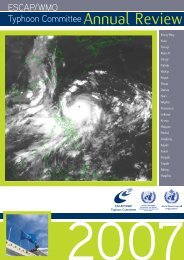TCAR - Typhoon Committee
TCAR - Typhoon Committee
TCAR - Typhoon Committee
You also want an ePaper? Increase the reach of your titles
YUMPU automatically turns print PDFs into web optimized ePapers that Google loves.
<strong>TCAR</strong><br />
CHAPTER 1 - TYPHOON COMMITTEE ACTIVITIES<br />
a) (b)<br />
Fig. 37. (a) KMA’s weather radar network; (b) Gangneung weather radar site<br />
Adoption of 4DVAR<br />
Based on KMA’s strategic plans, the current<br />
operational NWP system will be replaced with the<br />
UK’s Met Office Unified Model (UM) in 2010 and<br />
the data assimilation method will be upgraded<br />
to 4DVAR. With help from the Australian Bureau<br />
of Meteorology, the UM’s MetDB (Meteorological<br />
Data Bank) will be replaced with the ODB<br />
(Observation Data Base) to maximize portability<br />
and scalability of its OPS (Observation Processing<br />
System). Since April 2009, KMA has been<br />
running 4DVAR every 6 hours with a 6-hour<br />
window on the locally received observations in<br />
parallel with the existing operational NWP system<br />
so as evaluate the performance of the UM prior<br />
to full operation. The performance of the UM has<br />
so far proven promising with support from the<br />
large volume of data assimilated in 4DVAR.<br />
The volume of satellite data has considerably<br />
increased with the adoption of 4DVAR. Satellite<br />
data is needed to fill data void areas such as<br />
the ocean where typhoons may linger. More<br />
AMV data from GOES, MTSAT and METEOSAT<br />
have been used in 4DVAR on the UM compared<br />
with the existing operational NWP system.<br />
The quantity of ATOVS and MODIS data has<br />
also increased considerably. SSMI, AIRS, and<br />
ASCAT data, which were not used in the existing<br />
operational NWP system, were newly assimilated<br />
with 4DVAR. Fig. 38 illustrates the horizontal<br />
distribution of the observations received through<br />
GTS and ftp for a day in October.<br />
Data coverage over the ocean is greatly<br />
36<br />
enhanced by satellite observations and the<br />
reliability of typhoon forecast is expected to<br />
improve significantly as well. The data quantity<br />
used in one cycle of 4DVAR is listed in table 1.<br />
Recently, IASI (Infrared Atmospheric Sounding<br />
Interferometer) data were assimilated into the<br />
UM and their impact was evaluated. The RMSE<br />
of 5-day forecast GPH is reduced 1-5% with<br />
the IASI data. The improvement is large in the<br />
tropics where typhoons form.<br />
2009<br />
113

















